Kratom, a natural plant from Southeast Asia, has gained popularity for its diverse effects, ranging from pain relief and energy enhancement to mood improvement and relaxation. However, like many substances, regular use of kratom can lead to tolerance. When tolerance builds, users may find that their usual dose is no longer effective, prompting them to increase their intake, which can become both costly and counterproductive. Fortunately, there are strategies to manage and even prevent tolerance buildup: switching between different kratom strains and mixing them.
Understanding Kratom Tolerance
Kratom tolerance occurs when the body becomes accustomed to the presence of alkaloids (the active compounds in kratom), leading to diminished effects over time. The primary alkaloids in kratom, mitragynine and 7-hydroxymitragynine, interact with opioid receptors in the brain, producing the plant’s varied effects. Regular exposure to these alkaloids can cause the receptors to become less responsive, necessitating higher doses to achieve the same effects.
The Role of Switching Strains
Switching between different kratom strains is a common technique used by experienced kratom users to manage tolerance. Each kratom strain contains a unique profile of alkaloids, which can produce slightly different effects. By rotating between strains, you can vary the alkaloid exposure, reducing the likelihood of tolerance building up to any single strain.
Types of Kratom Strains
- Red Vein Kratom: Known for its pain-relieving and sedative properties, red vein kratom strains like Red Bali and Red Maeng Da are often used for relaxation and pain management.
- Green Vein Kratom: Green strains, such as Green Malay and Green Maeng Da, offer a balanced mix of pain relief, energy, and mood enhancement. They are ideal for users seeking a moderate, well-rounded effect.
- White Vein Kratom: White strains, like White Borneo and White Thai, are known for their stimulating and euphoric effects. They are popular among users needing an energy boost and improved focus.
- Yellow Vein Kratom: Yellow strains, such as Yellow Vietnam, are created through a unique drying process and provide mild energy and mood-enhancing effects, sitting somewhere between white and green strains.
Benefits of Strain Rotation
- Preventing Tolerance: By switching strains regularly, you can prevent your body from becoming too accustomed to any single set of alkaloids, thereby maintaining the efficacy of kratom.
- Enhanced Effects: Different strains can produce different effects. Rotating strains allows users to enjoy the full spectrum of kratom’s benefits, from energy and focus to relaxation and pain relief.
- Avoiding Overuse: Consistently using the same strain may lead to taking larger doses to achieve the desired effect. Rotation helps maintain lower, effective doses.
How to Rotate Kratom Strains
- Daily Rotation: Switch strains every day to ensure a varied alkaloid profile. For example, use White Vein on Monday, Green Vein on Tuesday, Red Vein on Wednesday, and so on.
- Weekly Rotation: Use one strain for a week and then switch to a different strain the next week. This approach provides consistency while still varying alkaloid exposure.
- Custom Rotation: Adjust the rotation schedule based on your needs and preferences. Some users may find a bi-weekly or monthly rotation more suitable.
The Power of Mixing Kratom Strains
In addition to switching strains, mixing different kratom strains can also help manage tolerance. By combining strains, you can create a custom blend that offers a unique balance of effects, reducing the likelihood of developing tolerance to any single strain.
Benefits of Mixing Strains
- Synergistic Effects: Combining strains can produce synergistic effects, where the combined benefits are greater than the sum of their parts. For example, mixing a red strain for pain relief with a white strain for energy can provide comprehensive, balanced effects.
- Customized Experience: Mixing strains allows users to tailor their kratom experience to their specific needs, whether it’s enhanced focus, better pain management, or improved mood.
- Varied Alkaloid Profile: A mixed blend offers a broader range of alkaloids, which can help prevent tolerance by ensuring the body is not overexposed to any single alkaloid profile.
How to Mix Kratom Strains
- Complementary Blends: Combine strains that complement each other’s effects. For example, mix a relaxing red strain with a stimulating white strain to balance energy and relaxation.
- Equal Parts: Start with equal parts of each strain and adjust based on your desired effects. A common mix might include equal parts of red, green, and white strains.
- Experimentation: Don’t be afraid to experiment with different ratios and combinations to find what works best for you. Keep notes on the effects of each blend to refine your mixes over time.
Practical Tips for Managing Kratom Tolerance
- Take Regular Breaks: Periodically taking a break from kratom can help reset your tolerance levels. Even a short break of a few days can make a significant difference.
- Stay Hydrated: Proper hydration can enhance kratom’s effects and improve overall well-being.
- Healthy Lifestyle: Maintaining a healthy lifestyle with a balanced diet, regular exercise, and adequate sleep can support kratom’s effectiveness and overall health.
- Mindful Dosage: Be mindful of your dosage and avoid increasing it unnecessarily. Start with the lowest effective dose and only increase if absolutely necessary.
Conclusion
Managing kratom tolerance is essential for maintaining its benefits and avoiding the pitfalls of overuse. By switching between different kratom strains and mixing them, users can enjoy the diverse effects of kratom while minimizing the risk of tolerance buildup. This approach not only enhances the overall kratom experience but also ensures that users can continue to benefit from this remarkable plant in the long term.
Whether you are using kratom for pain relief, energy, mood enhancement, or any other purpose, adopting strategies like strain rotation and mixing can help you achieve the best results. Always remember to use kratom responsibly and consult with a healthcare professional if you have any concerns or underlying health conditions.

